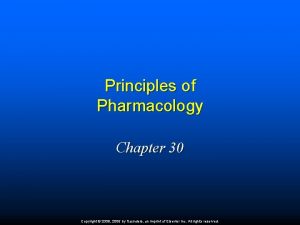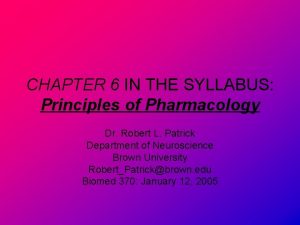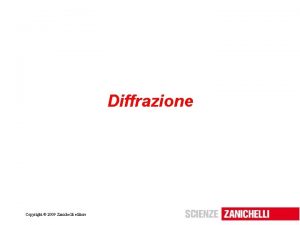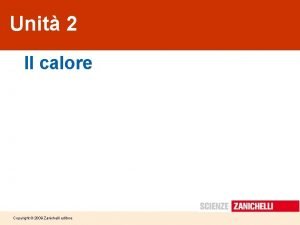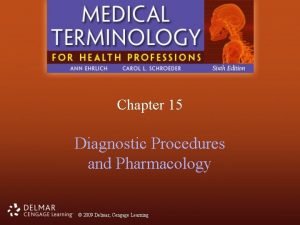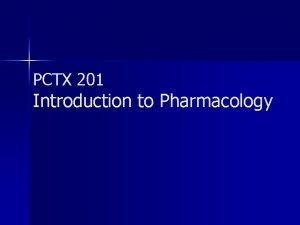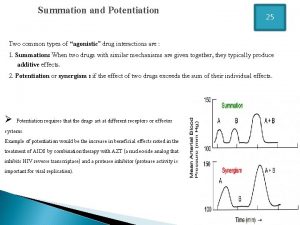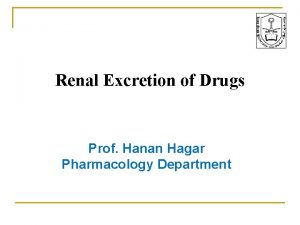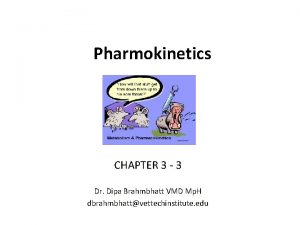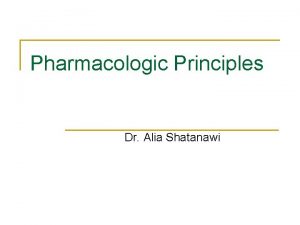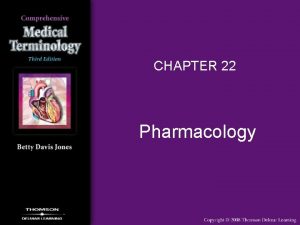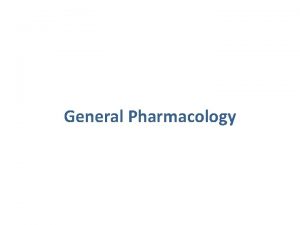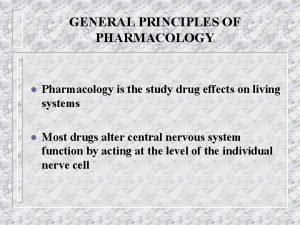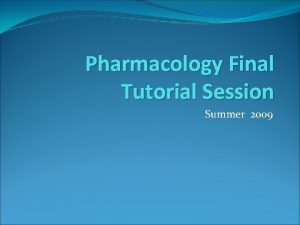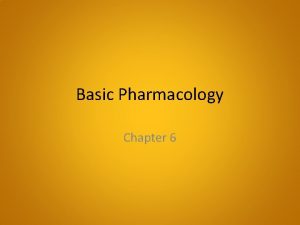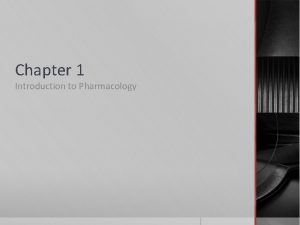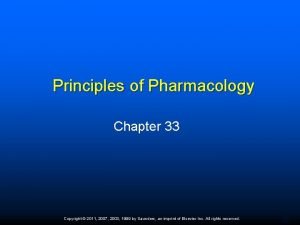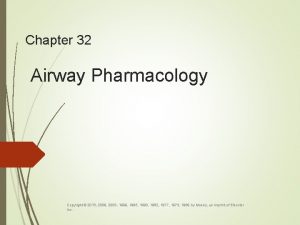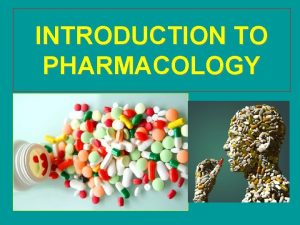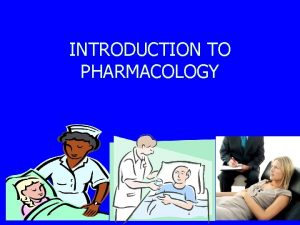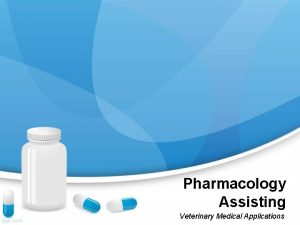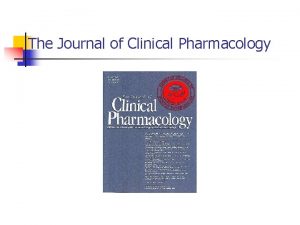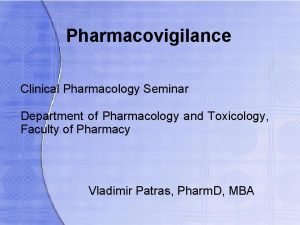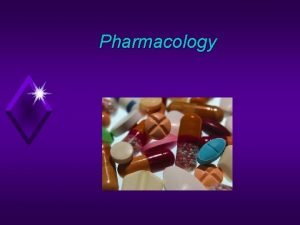Principles of Pharmacology Chapter 30 Copyright 2009 2006
























- Slides: 24

Principles of Pharmacology Chapter 30 Copyright © 2009, 2006 by Saunders, an imprint of Elsevier Inc. All rights reserved.

Chapter 30 Lesson 30. 1 Copyright © 2009, 2006 by Saunders, an imprint of Elsevier Inc. All rights reserved.

Learning Objectives Pronounce, define, and spell the Key Terms. Differentiate a drug’s chemical, generic, and brand or trade name. Define the Drug Enforcement Administration (DEA) and explain why drugs are categorized in five schedules of the Controlled Substance Act. List each part of a prescription. Describe the use of drug reference materials. Copyright © 2009, 2006 by Saunders, an imprint of Elsevier Inc. All rights reserved.

Introduction Pharmacology is the science of researching and developing drugs and studying their uses. Copyright © 2009, 2006 by Saunders, an imprint of Elsevier Inc. All rights reserved.

Overview of Drugs Drug derivatives Organic: drugs derived from living organisms such as plants or animals Ø Inorganic: drugs synthesized in the laboratory Ø Identifying drugs Chemical name: drug’s chemical formula Ø Generic name: name that any business firm may use Ø Brand or trade name: registered trademark Ø Copyright © 2009, 2006 by Saunders, an imprint of Elsevier Inc. All rights reserved.

Dispensing of Drugs are classified in two categories: Patent medicines (over-the-counter) • Drugs that can be obtained without a prescription Ø Prescription drugs • Also referred to as “ethical drugs” • Supplied by a pharmacist who has received a Ø prescription Copyright © 2009, 2006 by Saunders, an imprint of Elsevier Inc. All rights reserved.

The Prescription Written order by a physician or dentist for the preparation and administration of a medicine by the pharmacist Prescription terminology Superscription: patient name, address, date, Rx Ø Inscription: name and quantity of the drug Ø Subscription: directions for mixing the drug Ø Signature: instructions to the patient on how to take the drug Ø Copyright © 2009, 2006 by Saunders, an imprint of Elsevier Inc. All rights reserved.

Fig. 30 -1 Example of a prescription pad. (Courtesy of Colwell, a division of Patterson Companies, Inc, 800 -637 -1140) Copyright © 2009, 2006 by Saunders, an imprint of Elsevier Inc. All rights reserved.

Table 30 -1 Common Prescription Abbreviations Copyright © 2009, 2006 by Saunders, an imprint of Elsevier Inc. All rights reserved.

Drug-Reference Materials Physicians’ Desk Reference Also referred to as the “PDR” Ø Updated source of information supplied by drug companies about their products Ø Available as a bound text or a CD-ROM Ø Package inserts Ø Information sheet describing a drug for the patient • Side effects • Adverse and long-term effects • Precautions • Contraindications • Dosage and route Copyright © 2009, 2006 by Saunders, an imprint of Elsevier Inc. All rights reserved.

Chapter 30 Lesson 30. 2 Copyright © 2009, 2006 by Saunders, an imprint of Elsevier Inc. All rights reserved.

Learning Objectives Cite the factors in determining the dosage of a drug. Describe how mediations are administered. Describe the stages a drug goes through in the body. Define the DEA and explain why drugs are categorized in five schedules of the Controlled Substance Act. Describe the classification of prescription drugs and their effects. Describe the effects of drug use. Copyright © 2009, 2006 by Saunders, an imprint of Elsevier Inc. All rights reserved.

Drug Dosage is the amount of a drug that a patient takes. Specific factors in determining the dosage are: Age Ø Weight Ø Time of day at which the drug is taken Ø Drug form Ø Patient tolerance of the drug Ø Other drugs the patient is taking Ø Copyright © 2009, 2006 by Saunders, an imprint of Elsevier Inc. All rights reserved.

Fig. 30 -2 Routes of drug administration. (From Young A, Procter D: Kinn’s the medical assistant: an applied learning approach, ed 9, Philadelphia, 2003, Saunders; Chester GA: Modern medical assisting, Philadelphia, 1998, Saunders; and Daniel SJ, Harfst SA: Mosby’s dental hygiene: concepts, cases, and competencies, 2004 update, St Louis, Mosby 2004) A, Oral route. B, Topical route. (Cont’d) Copyright © 2009, 2006 by Saunders, an imprint of Elsevier Inc. All rights reserved.

Fig. 30 -2 Routes of drug administration. (From Young A, Procter D: Kinn’s the medical assistant: an applied learning approach, ed 9, Philadelphia, 2003, Saunders; Chester GA: Modern medical assisting, Philadelphia, 1998, Saunders; and Daniel SJ, Harfst SA: Mosby’s dental hygiene: concepts, cases, and competencies, 2004 update, St Louis, 2004, Mosby 2004. ) (Cont’d) C, Transdermal route. D, Inhalation route. (Cont’d) Copyright © 2009, 2006 by Saunders, an imprint of Elsevier Inc. All rights reserved.

Fig. 30 -2 Routes of drug administration. (From Young A, Procter D: Kinn’s the medical assistant: an applied learning approach, ed 9, Philadelphia, 2003, Saunders; Chester GA: Modern medical assisting, Philadelphia, 1998, Saunders; and Daniel SJ, Harfst SA: Mosby’s dental hygiene: concepts, cases, and competencies, 2004 update, St Louis, Mosby 2004) (Cont’d) E, Transdermal route. F, Injection route. Copyright © 2009, 2006 by Saunders, an imprint of Elsevier Inc. All rights reserved.

Table 30 -2 Stages of Drug Action in the Body Copyright © 2009, 2006 by Saunders, an imprint of Elsevier Inc. All rights reserved.

Controlled Substances Act DEA Scheduled drugs: Schedule I: no current accepted medical usefulness and a high potential for abuse Ø Schedule II: high potential for abuse but accepted medical usefulness as well Ø Schedule III: less abuse potential and accepted medical uses Ø Schedule IV: low abuse potential and accepted medical uses. Ø Schedule V: not required to be prescribed Ø Copyright © 2009, 2006 by Saunders, an imprint of Elsevier Inc. All rights reserved.

Classification of Drugs Why do I need to know different drug classifications? Helpful when reviewing a patient’s drug history Ø Gives knowledge of patients requiring premedication Ø Useful in dental procedures requiring different types of pain control Ø Assistance in a medical emergency Ø Copyright © 2009, 2006 by Saunders, an imprint of Elsevier Inc. All rights reserved.

Antibiotic Prophylaxis Antibiotics are prescribed to an uninfected patient to prevent bacterial colonization. The most common application is the prevention of infective endocarditis. Ø Bacteria are abundant in the oral cavity. • The antibiotic decreases the bacterial colonization or Ø adherence. Copyright © 2009, 2006 by Saunders, an imprint of Elsevier Inc. All rights reserved.

Antibiotic Prophylaxis Recommendations Copyright © 2009, 2006 by Saunders, an imprint of Elsevier Inc. All rights reserved.

Table 30 -3 Recommended Doses and Regimens for Common Antibiotics Copyright © 2009, 2006 by Saunders, an imprint of Elsevier Inc. All rights reserved.

Adverse Drug Effects Side effects Ø Allergic reactions Ø Sudden onset of an allergic reaction to a drug Drug tolerance Ø Increased sensitivity to a substance Anaphylaxis Ø Body’s reaction to a drug Loss of effectiveness of a drug Drug addiction Ø Physical dependence on a certain drug Copyright © 2009, 2006 by Saunders, an imprint of Elsevier Inc. All rights reserved.

Common Side Effects of Medications Copyright © 2009, 2006 by Saunders, an imprint of Elsevier Inc. All rights reserved.
 Chapter 30 principles of pharmacology
Chapter 30 principles of pharmacology Basic principles of pharmacology
Basic principles of pharmacology Basic principles of pharmacology
Basic principles of pharmacology 2009 pearson education inc
2009 pearson education inc International color standards
International color standards Dell all rights reserved copyright 2009
Dell all rights reserved copyright 2009 Copyright 2009 pearson education inc
Copyright 2009 pearson education inc Diffrazione luce zanichelli
Diffrazione luce zanichelli Copyright 2009
Copyright 2009 Calore e temperatura zanichelli
Calore e temperatura zanichelli Copyright 2009 pearson education inc
Copyright 2009 pearson education inc Copyright 2009 pearson education inc
Copyright 2009 pearson education inc 2009 pearson education inc
2009 pearson education inc Copyright 2009 pearson education inc
Copyright 2009 pearson education inc Copyright 2006
Copyright 2006 Copyright 2006
Copyright 2006 Chapter 15 diagnostic procedures and pharmacology
Chapter 15 diagnostic procedures and pharmacology Pharmacology chapter 1
Pharmacology chapter 1 Pharmacology and venipuncture
Pharmacology and venipuncture Potentiation example
Potentiation example What are the factors affecting drug distribution
What are the factors affecting drug distribution What is ion trapping in pharmacology
What is ion trapping in pharmacology Glucouronide
Glucouronide First bypass effect
First bypass effect Alia drug testing
Alia drug testing
